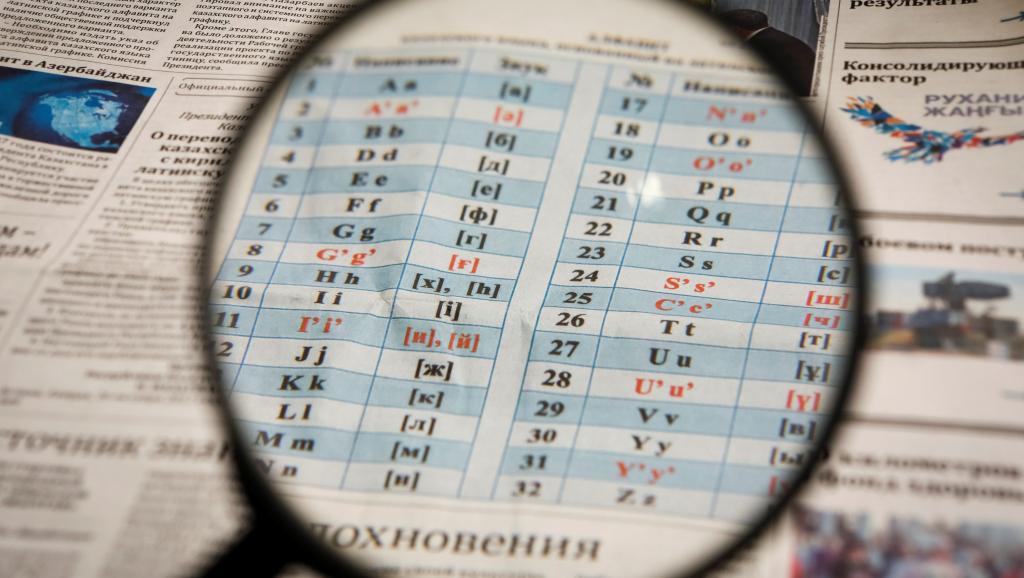The Kazakhstani government is aiming to transition the written form of the Kazakh language to a Latin-based script by 2025, Kazakh government officials said on Tuesday, reacting to Russian media statements stating that the change from the Cyrillic script could drag on for more than 10 years.
Earlier this week, the Russian daily Izvestiya reported that unnamed officials in Nur-Sultan (formerly called Astana) could fail to meet the deadline set by former President Nursultan Nazarbayev and stretch the process out of 2035.
But Kazakhstan’s government pushed back on the claim.
“The information that the transition to the Latin script will last until 2030-2035 is not true,” said Galymzhan Meldeshov, chairman of the language policy committee at the Ministry of Culture, according to a statement published to the ministry’s website on Tuesday.
Kazakhstan is changing its alphabet from Cyrillic script to the Latin-based style incrementally, which is slated to be completed by 2025.
The project consists of three stages, with the first already underway and providing for the development of spelling rules as well as launch digital applications. The second stage, which begins in 2021, will include translation of existing laws and re-issuance of passports, certificates and licenses. The last and final stage, set to begin no sooner than 2023, will consist of making changes to central government agencies, local executive bodies, state media and educational organizations.
News of writing what is a Turkic language, which is closely related to Turkish and the languages spoken in other Turkic states such as Azerbaijan, Uzbekistan and Turkmenistan, first broke in 2017, when Nazarbayev ordered that Kazakh be written in a more easily understandable script.
Following public debates, a draft version of the Latin-based alphabet, which included 32 letters, was introduced; however, it was later modified. The revised version uses diacritical marks to denote sounds found in the Kazakh language that are not present, for example, in English or European Romance languages.
The government budgeted about $664 million for the massive undertaking, and some experts expect that number to rise, as all government materials, signage and academic course materials will need to be reprinted in order to make the switch from a script most closely associated with Russian to one used in the west.
Earlier this year, the national currency, the tenge was redesigned following a presidential decree. A text of inscriptions used in design of banknotes and coins is now drawn up in the national language, while the new design of investment and collectible coins may include inscriptions in foreign languages.
In February, software developers from Kazakhstan introduced digital applications, including a multifunctional converter that allows shifting text written in Cyrillic script to the new Latin-based version. As part of the presentation, developers converted a Kazakh epic novel, “The Path of Abai” – a two-volume book that totals more than 1,200 pages – in just six seconds.
Meanwhile, the change of the national alphabet elicited some concerns in Kazakhstan.
Zhanar, a student from Nur-Sultan, believes that the new alphabet has already raised serious questions.
“Sure, my parents and even my grandmother are interested as they are learning Latin-based Kazakh as some new language,” she told Izvestiya. “But if it concerns serious documents, the same payments for housing and communal services or credit agreements in a bank, I think they will have serious problems.”
A Latin alphabet for Kazakh was first introduced by the Soviets and used from 1927 to 1940, at which time it was replaced with Cyrillic. Before that, Kazakhs used the Arabic alphabet to write in their native language.







 The number of evacuees from flooded areas in Kazakhstan has reached 97,852 people, including about 32,856 children since March 27.
The number of evacuees from flooded areas in Kazakhstan has reached 97,852 people, including about 32,856 children since March 27.
 The Islamic holy month of fasting, Ramadan comes to an end this week with the celebration of a joyous festival called Eid (meaning “festival” in Ar...
The Islamic holy month of fasting, Ramadan comes to an end this week with the celebration of a joyous festival called Eid (meaning “festival” in Ar...
 Iran's senior military leaders described the drone and missile attack on Israel on April 14 night as “successful".
Iran's senior military leaders described the drone and missile attack on Israel on April 14 night as “successful".
 Iranian President Ebrahim Raisi warned Israel that it would face a "real and extensive" response if it makes any "mistake" following Tehran’s missi...
Iranian President Ebrahim Raisi warned Israel that it would face a "real and extensive" response if it makes any "mistake" following Tehran’s missi...



